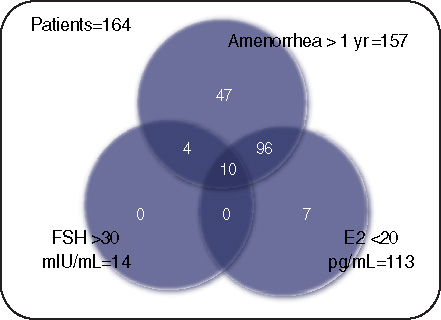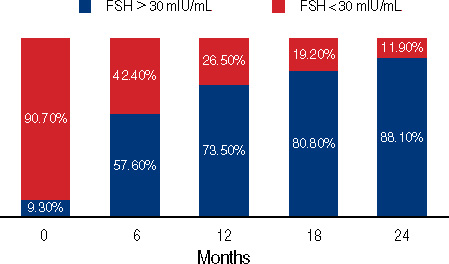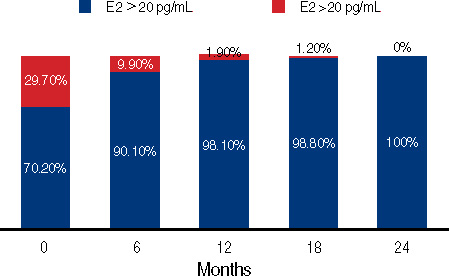J Breast Cancer.
2010 Dec;13(4):375-381. 10.4048/jbc.2010.13.4.375.
Hormonal Changes during Extended Letrozole Treatment after Completion of 5 Years of Tamoxifen in Premenopausal Patients with Breast Cancer who Became Postmenopausal
- Affiliations
-
- 1Division of Breast and Endocrine Surgery, Department of General Surgery, Asan Medical Center, University of Ulsan College of Medicine, Seoul, Korea. ahnsh@amc.seoul.kr
- KMID: 2286525
- DOI: http://doi.org/10.4048/jbc.2010.13.4.375
Abstract
- PURPOSE
Extended treatment with aromatase inhibitors (AIs) after tamoxifen has shown effectiveness in postmenopausal patients with breast cancer. However it is very difficult to start on AIs for patients who become postmenopausal after tamoxifen because tamoxifen is a selective estrogen receptor modulator (SERM) that influences menopause, confusing the menopausal status of patients. We assessed the menopausal status and hormone concentrations at the start of letrozole treatment in women with breast cancer who were premenopausal when diagnosed with breast cancer and who became postmenopausal during 5 years of tamoxifen therapy.
METHODS
We evaluated 164 patients with breast cancer who received extended letrozole therapy between May 2006 and December 2007. All had been premenopausal at diagnosis but became postmenopausal during 5 years of tamoxifen therapy. Menopause was defined as amenorrhea for >1 year, serum follicle stimulating hormone (FSH) concentration > or =30 mIU/mL or serum estradiol (E2) concentrations < or =20 pg/mL. FSH and E2 concentrations were monitored for 2 years after starting letrozole therapy.
RESULTS
The median ages of the 164 patients were 45 years at surgery, 46 years when they became amenorrheic, and 50 years at the start of letrozole treatment. Of the 164 patients, 157 (95.7%) were amenorrheic, 14 (9.3%) had FSH concentrations > or =30 mIU/mL and 113 (70.2%) had E2 concentrations < or =20 pg/mL at the start of letrozole. FSH concentrations > or =30 mIU/mL were observed in 87 patients (57.6%) after 6 months of letrozole and in 133 (88.1%) after 2 years, and E2 concentrations < or =20 pg/mL were observed in 164 patients (100%) after 2 years. Times to reach FSH > or =30 mIU/mL and E2 levels < or =20 pg/mL were not significantly related to age at surgery (p=0.836 and p=0.228, respectively), at start of letrozole (p=0.855 and p=0.357, respectively), or at amenorrhea (p=0.098 and p=0.154, respectively).
CONCLUSION
Applying postmenopausal ranges of hormone concentrations observed in normal healthy people to patients who completed 5 years of tamoxifen is inappropriate, because tamoxifen itself may affect FSH concentration. Further studies should focus on identifying an indicator of ovarian function so that these patients can start extended hormone therapy.
MeSH Terms
Figure
Reference
-
1. Toniolo PG, Levitz M, Zeleniuch-Jacquotte A, Banerjee S, Koenig KL, Shore RE, et al. A prospective study of endogenous estrogens and breast cancer in postmenopausal women. J Natl Cancer Inst. 1995. 87:190–197.
Article2. Lerner LJ, Jordan VC. Development of antiestrogens and their use in breast cancer: eighth Cain memorial award lecture. Cancer Res. 1990. 50:4177–4189.3. Jordan VC. Long-term adjuvant tamoxifen therapy for breast cancer. Breast Cancer Res Treat. 1990. 15:125–136.
Article4. Goss PE, Ingle JN, Martino S, Robert NJ, Muss HB, Piccart MJ, et al. A randomized trial of letrozole in postmenopausal women after five years of tamoxifen therapy for early-stage breast cancer. N Engl J Med. 2003. 349:1793–1802.
Article5. The Korean. Nationwide Korean breast cancer data of 2004 using breast cancer registration program. J Breast Cancer. 2006. 9:151–161.
Article6. Ahn SH, Yoo KY. Korean Breast Cancer Society. Chronological changes of clinical characteristics in 31,115 new breast cancer patients among Koreans during 1996-2004. Breast Cancer Res Treat. 2006. 99:209–214.
Article7. Walshe JM, Denduluri N, Swain SM. Amenorrhea in premenopausal women after adjuvant chemotherapy for breast cancer. J Clin Oncol. 2006. 24:5769–5779.
Article8. Morimoto T, Okazaki M, Endo T. Current status and goals of mammographic screening for breast cancer in Japan. Breast Cancer. 2004. 11:73–81.
Article9. Baum M, Budzar AU, Cuzick J, Forbes J, Houghton JH, Klijn JG, et al. Anastrozole alone or in combination with tamoxifen versus tamoxifen alone for a adjuvant treatment of postmenopausal women with early breast cancer: first results of the ATAC randomized trial. Lancet. 2002. 359:2131–2139.10. Coates AS, Keshaviah A, Thurlimann B, Mouridsen H, Mauriac L, Forbes JF, et al. Five years of letrozole compared with tamoxifen as initial a adjuvant therapy for postmenopausal women with endocrine-responsive early breast cancer: update of study BIG 1-98. J Clin Oncol. 2007. 25:486–492.
Article11. Jonat W, Gnant M, Boccardo F, Kaufmann M, Rubagotti A, Zuna I, et al. Effectiveness of switching from adjuvant tamoxifen to anastrozole in postmenopausal women with hormone-sensitive early-stage breast cancer: a meta analysis. Lancet Oncol. 2006. 7:991–996.
Article12. Coombes RC, Hall E, Gibson LJ, Paridaens R, Jassem J, Delozier T, et al. A randomized trial of exemestane after two to three years of tamoxifen therapy in postmenopausal women with primary breast cancer. N Engl J Med. 2004. 350:1081–1092.
Article13. Goss PE, Ingle JN, Martino S, Robert NJ, Muss HB, Piccart MJ, et al. Randomized trial of letrozole following tamoxifen as extended adjuvant therapy in receptor-positive breast cancer: updated findings from NCIC CTG MA.17. J Natl Cancer Inst. 2005. 97:1262–1271.
Article14. DeGrendele H. Benefit of letrozole in postmenopausal women after five years of tamoxifen therapy for early-stage breast cancer. Clin Breast Cancer. 2003. 4:311–312.
Article15. Aksoy S, Dizdar O, Altundag K. Definition of postmenopausal status, age of the breast cancer patients and the outcome of aromatase inhibitors treatment. Breast. 2008. 17:433–435.
Article16. Kim HA, Shin DS, Moon NM, Paik NS, Noh WC. The incidence of chemotherapy-induced amenorrhea and recovery in young (45-year-old) breast cancer patients. J Breast Cancer. 2009. 12:20–26.
Article17. Kavak ZN, Binöz S, Ceyhan N, Pekin S. The effect of tamoxifen on the endometrium, serum lipids and hypothalamus pituitary axis in the postmenopausal breast cancer patients. Acta Obstet Gynecol Scand. 2000. 79:604–607.
Article18. Ellmén J, Hakulinen P, Partanen A, Hayes DF. Estrogenic effect of toremifen and tamoxifen in postmenopausal breast cancer patients. Breast Cancer Res Treat. 2003. 82:103–111.
Article19. Jordan VC, Fritz NF, Tormey DC. Endocrine effects of adjuvant chemotherapy and long-term tamoxifen administration on node-positive patients with breast cancer. Cancer Res. 1987. 47:624–630.20. Samaan NA, deAsis DN Jr, Buzdar AU, Blumenschein GR. Pituitary-ovarian function in breast cancer patients on a adjuvant chemoimmunotherapy. Cancer. 1978. 41:2084–2087.
Article21. McFadyen IJ, Raab G, Forrest AP, Langlands AO, Stewart HJ, Roberts MM, et al. The effect of tamoxifen and stilboestrol on plasma hormone levels in postmenopausal women with advanced breast cancer. Clin Oncol. 1979. 5:251–256.22. Golder MP, Phillips ME, Fahmy DR, Preece PE, Jones V, Henk JM, et al. Plasma hormones in patients with advanced breast cancer treated with tamoxifen. Eur J Cancer. 1976. 12:719–723.
Article23. Delrio G, Placido S, pagliarulo C, d'Istria M, Fasano S, Marinelli A, et al. Hypothalamic-pituitary-ovarian axis in women with operable breast cancer treated with adjuvant CMF and tamoxifen. Tumori. 1986. 72:53–61.
Article24. Rossi E, Morabito A, Di Rella F, Esposito G, Gravina A, Labonia V, et al. Endocrine effects of adjuvant letrozole compared with tamoxifen in hormone-responsive postmenopausal patients with early breast cancer: the HOBOE trial. J Clin Oncol. 2009. 27:3192–3197.
Article25. Burstein HJ, Prestrud AA, Seidenfeld J, Anderson H, Buchholz TA, Davidson NE, et al. American Society of Clinical Oncology practice giudeline: update on adjuvant endocrine therapy for women with hormone receptor-positive breast cancer. J Clin Oncol. 2010. 28:3784–3796.
Article26. Bines J, Oleske DM, Cobleigh MA. Ovarian fuction in premenopusal women treated with adjuvant chemotherapy for breast cancer. J Clin Oncol. 1996. 14:1718–1729.
Article27. Goodwin PJ, Ennis M, Pritchard KI, Trudeau M, Hood N. Risk of menopause during the first year after breast cancer diagnosis. J Clin Oncol. 1999. 17:2365–2370.
Article28. Amir E, Seruga B, Freedman O, Clemons M. Amenorrhea, menopause, and endocrine therapy for breast cancer. BMJ. 2009. 339:b4261.29. Smith IE, Dowsett M, Yap YS, Walsh G, Lønning PE, Santen RJ, etl al. Adjuvant aromatase inhibitors for early breast cancer after chemotherapy-induced amenorrhoea: caution and suggested guidelines. J Clin Oncol. 2006. 24:2444–2447.
Article30. Goss PE, Ingle JN, Pater JL, Martino S, Robert NJ, Muss HB, et al. Late extended adjuvant treatment with letrozole improves outcome in women with early-stage breast cancer who complete 5 years of tamoxifen. J Clin Oncol. 2008. 26:1948–1955.
Article
- Full Text Links
- Actions
-
Cited
- CITED
-
- Close
- Share
- Similar articles
-
- The effect of adjuvant hormonal therapy on the endometrium and ovary of breast cancer patients
- The Change of Endometrial Thickness in Tamoxifen-treated Postmenopausal Breast Cancer Patients
- Cost-Effectiveness Analysis of Adjuvant Hormonal Treatments for Women with Postmenopausal Hormone-Receptor Positive Early Breast Cancer in the Korean Context
- Endocrine Therapy for Breast Cancer
- Tamoxifen Resistance and Crosstalk of Signal Transduction in Breast Cancer




